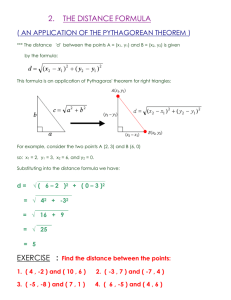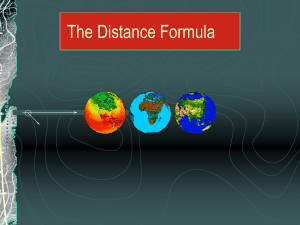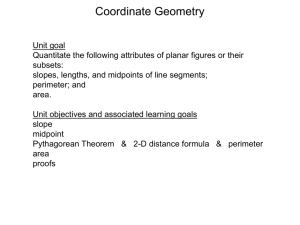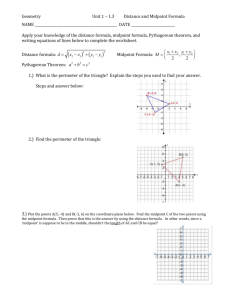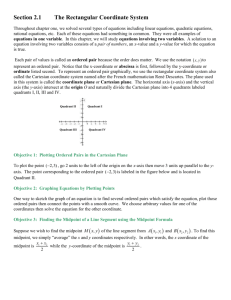1.1 Notes (Completed) - Fort Thomas Independent Schools
advertisement
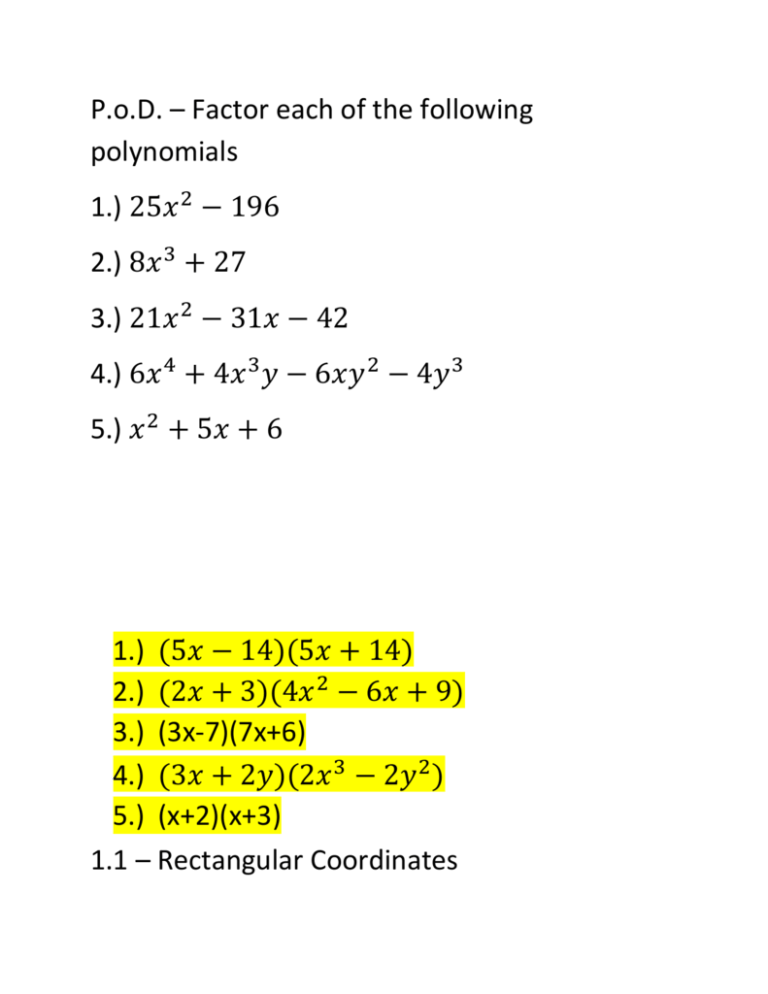
P.o.D. – Factor each of the following polynomials 1.) 25𝑥 2 − 196 2.) 8𝑥 3 + 27 3.) 21𝑥 2 − 31𝑥 − 42 4.) 6𝑥 4 + 4𝑥 3 𝑦 − 6𝑥𝑦 2 − 4𝑦 3 5.) 𝑥 2 + 5𝑥 + 6 1.) (5𝑥 − 14)(5𝑥 + 14) 2.) (2𝑥 + 3)(4𝑥 2 − 6𝑥 + 9) 3.) (3x-7)(7x+6) 4.) (3𝑥 + 2𝑦)(2𝑥 3 − 2𝑦 2 ) 5.) (x+2)(x+3) 1.1 – Rectangular Coordinates Learning Target(s): I can plot points in the Cartesian plane; use the distance formula to find the distance between two points; use the midpoint formula to find the midpoint of a line segment; use geometric formulas to model real-life problems. Cartesian Coordinate Plane: - Named after Rene Descartes - Contains 4 quadrants, two axes (x- and yaxis), origin (intersection of the axes) Quadrant II Quadrant I (-,+) (+,+) Quadrant III (-,-) Quadrant IV (+,-) Each point (x,y) in the coordinate plane is known as an ordered pair. EX: Plot the points (1,-2), (4,-3), (0,0), (5,0), and (-3,-1) EX: Sketch a scatter plot for the following data set: X Y 0 1 1 3 2 6 3 8 4 4 5 5 6 7 7 8 8 10 *Show how to sketch a scatter plot using the graphing calculator. The Pythagorean Theorem & The Distance Formula: Pythagorean Theorem: 𝑎2 + 𝑏 2 = 𝑐 2 , where a and b are the legs of a right triangle and c is the hypotenuse. Distance Formula: - This is simply an adaptation of the Pythagorean Theorem - 𝑑 = √(𝑥2 − 𝑥1 )2 + (𝑦2 − 𝑦1 )2 - http://www.youtube.com/watch?v=YBeXhGl6pSE EX: Find the distance between the points (-5,7) and (3,-4). 𝑑 = √(3 − (−5))2 + (−4 − 7)2 = √82 + (−11)2 = √64 + 121 = √185 ≈ 13.6 *Let’s write a calculator program to find distance. Verifying a Right Triangle: - If a triangle is right, it will satisfy the Pythagorean Theorem. - Thus, we need to know the lengths of the sides of the triangle, understanding that the longest side must be the hypotenuse. EX: Show that the points A(4,0), B(2,1), and C(-1,-5) are vertices of a right triangle. Begin by finding the distance of all 3 sides. 𝐴𝐵 = √(2 − 4)2 + (1 − 0)2 = √(−2)2 + 12 = √4 + 1 = √5 ≈ 2.236 𝐵𝐶 = √(−1 − 2)2 + (−5 − 1)2 = √(−3)2 + (−6)2 = √9 + 36 = √45 = 3√5 ≈ 6.708 𝐴𝐶 = √(−1 − 4)2 + (−5 − 0)2 = √(−5)2 + (−5)2 = √25 + 25 = √50 = 5√2 ≈ 7.071 AC is the hypotenuse. Now apply the Pythagorean Theorem. (√5)2 + (3√5)2 = (5√2)2 5 + 45 = 50 50 = 50 True. The Midpoint Formula: 𝑥1 + 𝑥2 𝑦1 + 𝑦2 𝑀𝑃 = ( , ) 2 2 - Think of the midpoint as the average of two ordered pairs. EX: Find the midpoint of the line segment joining the points (-6,1) and (7,4) −6 + 7 1 + 4 1 5 𝑀𝑃 = ( , )=( , ) 2 2 2 2 *Let’s make an addition to our distance program that will now compute midpoint. EX: During the 3rd quarter of a recent game, the university’s quarterback threw a pass from the 32 yard line, 40 yards from the sideline. The pass was caught by the wide receiver on the 3 yard line, 15 yards from the sideline. How long was the pass? (40,32) (15,3) - We need to use the distance formula. 𝑑 = √(40 − 15)2 + (32 − 3)2 = √1466 ≈ 38.29 EX: A local contracting company had annual revenue of $15 million in 2003 and $17.2 million in 2005. Without knowing any additional information, what figure would you estimate the 2004 revenue to have been? - We need to assume that this is a linear relationship. Therefore, we simply need to find the midpoint of (2003, 15) and (2005,17.2). 2003 + 2005 15 + 17.2 𝑀𝑃 = ( , ) 2 2 32.2 = (2004, ) = (2004,16.1) 2 $16.1 million EX: A triangle has vertices at (-1,-3), (5,1), and (2,4). Shift the triangle two units to the left and three units downward, and find the vertices of the shifted triangle. (−1, −3) → (−1 − 2, −3 − 3) = (−3, −6) (5,1) → (5 − 2,1 − 3) = (3, −2) (2,4) → (2 − 2,4 − 3) = (0,1) *Study and memorize the formulas for Area, Perimeter, Circumference, and Volume in the box on the bottom of page 7. EX: A beach ball has a volume of 904.32 cubic inches. Find the radius of the sphere. 4 3 Volume of a Sphere: 𝑉 = 𝜋𝑟 3 4 3 904.32 = 𝜋𝑟 3 3 904.32 ( ) = 𝜋𝑟 3 → 678.24 = 𝜋𝑟 3 4 678.24 = 𝑟 3 → 215.89 = 𝑟 3 𝜋 3 √215.89 = 𝑟 → 5.999 = 𝑟 Upon completion of this lesson, you should be able to: 1. Plot points on the coordinate grid 2. Utilize the Pythagorean Theorem and the distance formula. 3. Translate coordinates of polygons. 4. Solve formulas of geometric figures. For additional information, go to https://www.youtube.com/watch?v=awOYuKF_LII HW Pg.9 3-54 3rds, 63, 65, 81-88




